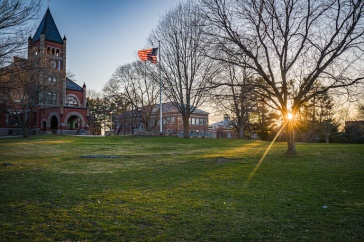
With a major National Science Foundation (NSF) CAREER grant, Cheryl Andam, assistant professor of molecular, cellular and biomedical sciences, aims to solve a microbial mystery: Why are members of a bacterial species so genetically diverse? Her findings could help us understand antibiotic resistance and the emergence of new diseases and, ultimately, lead to better diagnosis and treatment of bacterial infections.
“In order for bacteria to reproduce, they clone themselves. But they also acquire DNA from their neighbors,” including those of other species, says Andam. “It would be like humans getting DNA from mushrooms or giraffes or oak trees.”
Called horizontal gene transfer, this neighborly sharing means that individual cells of a bacterial species — E. coli, for instance, or Staphylococcus aureus — aren’t genetically identical.
“When you go to the clinic, the medical professionals collect samples from your mouth or nose, but they only study one strain, then they make prescriptions based on that one strain, without understanding that different strains can be very different from each other,” she says. “Hopefully in the future we can study all the different strains in a single patient and study all the genes that are present,” including those that might lead to antibiotic resistance.
With the $1.17 million grant, more than double the amount of most NSF CAREER awards, Andam will analyze genomic data from Streptomyces, a widespread group of bacteria that produces many useful antibiotics. She’ll work closely with UNH’s Hubbard Center for Genome Studies for the data-heavy work and will hire a postdoctoral researcher, several graduate students and many undergrads.
The award will also support Andam’s efforts to teach others — UNH undergraduates and graduate students — the same cross-disciplinary computational skills necessary to analyze massive data sets of genomic information through bioinformatics.
“If you’re a biology student, you’re being trained to work in a lab, to pipette and culture bacteria. But biology research is changing dramatically with the rapidly increasing rate of genome sequencing. Instead of studying just one gene or two genes, we study all of the genes in hundreds and hundreds of strains,” she says. “In order for you to analyze all that data, you need to improve your computational skills.”

Beyond culturing bacteria and crunching genomic data, Andam will use part of her CAREER award to mount an exhibit of microbial art. “Students will grow bacteria, and we’ll blow up photos of the agar plates,” she says. “It will highlight the tremendous diversity of microbes around us, in our purses or on doorknobs or computer keyboards.”
This early career recognition from NSF will do more than boost her research, Andam says. It addresses the imposter syndrome she shares with many women working in STEM.
“As a female scientist, I always question myself. Am I on the right track? Is this the right way of thinking about new ideas?” she says. “Getting this CAREER validates me as a scientist.”
-
Written By:
Beth Potier | UNH Marketing | beth.potier@unh.edu | 2-1566
















































